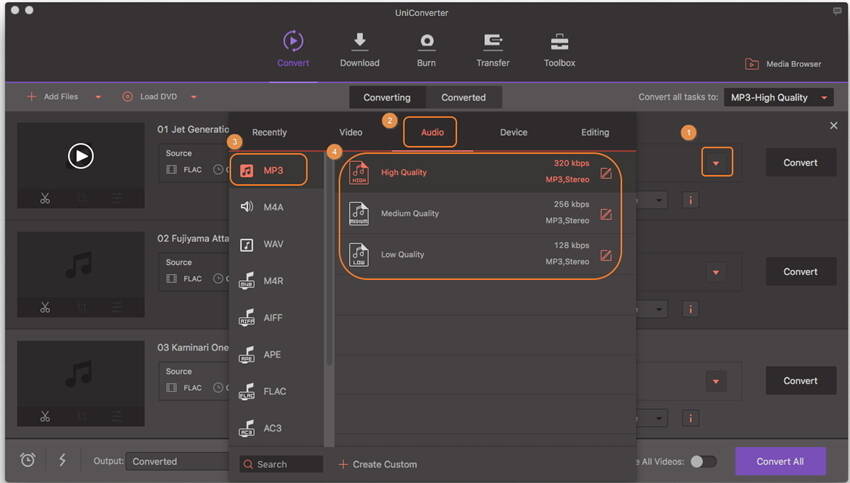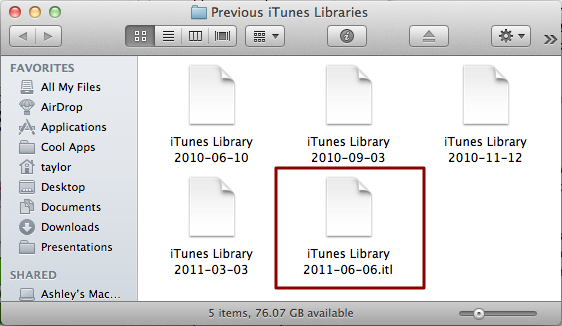
Convert music file formats in iTunes on Mac. You can convert a song to a different file format (and keep a copy of the original). For example, you can save a copy of a compressed song file such as MP3 or AAC in an uncompressed song format (AIFF or WAV). Apr 27, 2019 The file types that are compatible with iTunes include MP3, AAC, M4A, WAV, AIF, AIFF, M4R, and M4B. For these files, you can basically add them directly to your iTunes and play these songs. Now, let’s take you through the brief steps through which you can add songs from your USB to the iTunes Library. How to Convert MP3 to AIFF with One Click An audio file in AIFF format, is said to be in an uncompressed PCM (Pulse-Code Modulation). In short, it stores important audio information or data such as Channel, Sample Rate, Metadata, Annotation, Author, BitRate, Comment and so on.
| Filename extension | .aiff |
|---|---|
| Internet media type | audio/x-aiff |
| Type code | AIFF, AIFC |
| Uniform Type Identifier (UTI) | public.aiff-audio public.aifc-audio |
| Developed by | Apple Inc. |
| Initial release | January 21, 1988; 32 years ago[1] |
| Latest release | 1.3 (January 4, 1989; 31 years ago AIFF-C / July 1991; 28 years ago[2]) |
| Type of format | audio file format, container format |
| Extended from | IFF (File format) |
Audio Interchange File Format (AIFF) is an audio file format standard used for storing sound data for personal computers and other electronic audio devices. The format was developed by Apple Inc. in 1988 based on Electronic Arts' Interchange File Format (IFF, widely used on Amiga systems) and is most commonly used on Apple Macintosh computer systems.
The audio data in most AIFF files is uncompressed pulse-code modulation (PCM). This type of AIFF file uses much more disk space than lossy formats like MP3—about 10 MB for one minute of stereo audio at a sample rate of 44.1 kHz and a bit depth of 16 bits. There is also a compressed variant of AIFF known as AIFF-C or AIFC, with various defined compression codecs.
In addition to audio data, AIFF can include loop point data and the musical note of a sample, for use by hardware samplers and musical applications.
The file extension for the standard AIFF format is .aiff or .aif. For the compressed variants it is supposed to be .aifc, but .aiff or .aif are accepted as well by audio applications supporting the format.
AIFF on Mac OS X[edit]
With the development of the Mac OS X operating system, Apple created a new type of AIFF which is, in effect, an alternative little-endian byte order format.[3][4]
Because the AIFF architecture has no provision for alternative byte order, Apple used the existing AIFF-C compression architecture, and created a 'pseudo-compressed' codec called sowt (twos spelled backwards). The only difference between a standard AIFF file and an AIFF-C/sowt file is the byte order; there is no compression involved at all.[5]
Apple uses this new little-endian AIFF type as its standard on Mac OS X. When a file is imported to or exported from iTunes in 'AIFF' format, it is actually AIFF-C/sowt that is being used. When audio from an audio CD is imported by dragging to the Mac OS X Desktop, the resulting file is also an AIFF-C/sowt. In all cases, Apple refers to the files simply as 'AIFF', and uses the '.aiff' extension.
For the vast majority of users this technical situation is completely unnoticeable and irrelevant. The sound quality of standard AIFF and AIFF-C/sowt are identical, and the data can be converted back and forth without loss. Users of older audio applications, however, may find that an AIFF-C/sowt file will not play, or will prompt the user to convert the format on opening, or will play as static.
All traditional AIFF and AIFF-C files continue to work normally on Mac OS X (including on the new Intel-based hardware), and many third-party audio applications as well as hardware continue to use the standard AIFF big-endian byte order.
AIFF Apple Loops[edit]
Apple has also created another recent extension to the AIFF format in the form of Apple Loops[6] used by GarageBand and Logic Pro, which allows the inclusion of data for pitch and tempo shifting by an application in the more common variety, and MIDI-sequence data and references to GarageBand playback instruments in another variety.
AppleLoops use either the .aiff (or .aif) or .caf extension regardless of type.
Data format[edit]
An AIFF file is divided into a number of chunks.[7] Each chunk is identified by a chunk ID more broadly referred to as FourCC.
Types of chunks found in AIFF files:
- Common Chunk (required)
- Sound Data Chunk (required)
- Marker Chunk
- Instrument Chunk
- Comment Chunk
- Name Chunk
- Author Chunk
- Copyright Chunk
- Annotation Chunk
- Audio Recording Chunk
- MIDI Data Chunk
- Application Chunk
- ID3 Chunk
Metadata[edit]
AIFF files can store metadata in Name, Author, Comment, Annotation, and Copyright chunks. An ID3v2 tag chunk can also be embedded in AIFF files, as well as an Application Chunk with Extensible Metadata Platform (XMP) data in it.[8]
Common compression types[edit]
AIFF supports only uncompressed PCM data. AIFF-C also supports compressed audio formats, that can be specified in the 'COMM' chunk. The compression type is 'NONE' for PCM audio data. The compression type is accompanied by a printable name. Common compression types and names include, but are not limited to:
| Compression type | Compression name | Data | Source |
|---|---|---|---|
| NONE | not compressed | PCM, big-endian | Apple Inc. |
| sowt | not compressed | PCM, little-endian | Apple Inc. |
| fl32 | 32-bit floating point | IEEE 32-bit float | Apple Inc. |
| fl64 | 64-bit floating point | IEEE 64-bit float | Apple Inc. |
| alaw | ALaw 2:1 | 8-bit ITU-T G.711A-law | Apple Inc. |
| ulaw | μLaw 2:1 | 8-bit ITU-T G.711 μ-law | Apple Inc. |
| ALAW | CCITT G.711 A-law | 8-bit ITU-T G.711 A-law (64 kbit/s) | SGI |
| ULAW | CCITT G.711 u-law | 8-bit ITU-T G.711 μ-law (64 kbit/s) | SGI |
| FL32 | Float 32 | IEEE 32-bit float | SoundHack & Csound |
| ADP4 | 4:1 Intel/DVIADPCM | Stéphane Tavenard (Audio Convert/Player) AmigaOS | |
| ima4 | IMA 4:1 | ||
| ACE2 | ACE 2-to-1 | Apple IIGS ACE (Audio Compression/Expansion) | |
| ACE8 | ACE 8-to-3 | ||
| DWVW | Delta with variable word width | TX16W Typhoon | |
| MAC3 | MACE 3-to-1 | Apple Inc. | |
| MAC6 | MACE 6-to-1 | Apple Inc. | |
| Qclp | Qualcomm PureVoice | Qualcomm | |
| QDMC | QDesign Music | QDesign | |
| rt24 | RT24 50:1 | Voxware | |
| rt29 | RT29 50:1 | Voxware | |
| SDX2 | Square-Root-Delta | Big-endian | 3DO (Panasonic) / MAC (Apple) |
See also[edit]
- Apple Lossless (ALAC)
- RIFF, the little-endian format corresponding to IFF
References[edit]
- ^ abApple Computer, Inc. (1989-01-04), Audio Interchange File Format, A Standard for Sampled Sound Files, Version 1.3(PDF), retrieved 2010-03-21
- ^P. Kabal (2005-03-15). 'Audio File Format Specifications - AIFF / AIFF-C Specifications'. McGill University. Retrieved 2010-03-21.
- ^Mac OS X Reference Library
- ^Supported Audio File and Data Formats in Mac OS X
- ^'Technical Q&A QTMRF04: QuickTime Sound'. Apple. 1995-05-01. Retrieved 2009-11-09.
- ^'Logic Studio - Plug-ins & Sounds'. Apple. Retrieved 2010-04-30.
- ^Audio File Format Specifications
- ^'AIFF Tagging'.
- ^Tom Erbe (1999). 'AIFF-C Compression Types and Names'. Archived from the original on 2006-06-20. Retrieved 2010-03-21.
- ^'JSTOR/Harvard Object Validation Environment - AIFF-hul Module'. 2005-05-09. Archived from the original on 2010-06-29. Retrieved 2010-03-21.
External links[edit]
- Audio Interchange File Format AIFF-C - Draft 08/26/91 - Apple Computer, Inc. - (archive.org backup)
- Creating AIFF Audio Formatted Files - by Paul Bourke - (September 1996)
- AIFF / AIFC Sound File Specifications - Draft 17/11/17 - (archive.org backup)
Wonder about the ways to add files to iTunes without copying? Cannot add songs or your personal videos to iTunes 11? Well cheer up then, because here you can gain the simple and quick methods to add files to iTunes (including iTunes 11.3, 11.2, 11.1).
How to Add Your Songs, Videos, and Other Files to iTunes Library
iTunes library is an index from which you can add all music, videos and other contents to iTunes. More importantly, you can either add files from your computer directly to your iTunes library, or add music or videos to iTunes from external hard drive or CDs.


Part 1. Add Files to iTunes Library from Your Computer
If you want to add files from computer to iTunes, say photos, contacts, the video files or digital audio (including songs or voice memos), or other data, you can add all of them to iTunes by following the steps below:
- 1. Run iTunes on your computer. Note:Make sure you have the latest version of iTunes: for Windows, choose Help > Check for Updates; for Mac, choose iTunes > Check for Updates.
- 2. Click File menu and add data to iTunes.
For Windows: choose Add File to Library or Add Folder to Library.
For Mac: choose Add to Library
- 3. Navigate to and choose the file or the folder on your computer that you want to add to iTunes.
You can add music on your computer to iTunes that are in AAC, MP3, WAV, AIFF, Apple Lossless, or Audible.com (.aa) format. If you add unprotected WMA files to iTunes library on Windows OS, iTunes can convert these files to one of these formats.
Important Info: You can also add videos to iTunes from external hard drive referring to the above steps. Just insert the external hard drive which contains your data to your computer and start from step 1.
Part 2. Add Music to iTunes from CD/DVD
Aiff File Download
Just like the steps above on how to add files from PC to iTunes, adding music to iTunes library from CDs or DVDs is quite simple too.
- 1. Open iTunes and insert the CD/DVD into your computer's CD/DVD drive.
- 2. A dialog will appear to ask whether you want to import the CD. If you want to add all songs into iTunes library click 'Yes'; if you don't want to add all the songs, click 'No' and verify that all the wanted ones are ticked.
- 3. Then click the 'Import CD' button and wait for the importing process finishes.
Cannot Copy Aiff Files To Mac Library Software
Follow the steps introduced in each part and you would be never confused by such questions like 'how to add files from PC to iTunes'. To be added, if you have encrypted your iTunes backup file but forgot the password, you can try iPhone Backup Unlocker to unlock the password and get access to your iTunes backup files. If you have any problem, let us know by leaving it in your comment.